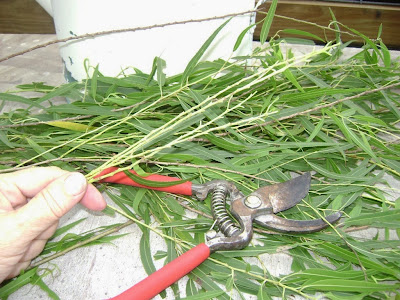Most gardeners familiar with root growth hormone and stimulators know that they can easily be purchased at most garden centers. I myself learned to propagate cuttings using them many years ago. The problem with them is that they are synthetic chemicals.
For those of you not familiar with the use of root growth hormones, they are used basically to speed up the process for new root growth. Newly propagated cuttings can also be easily infected by bacteria and fungi until they become mature enough to contain a protective property called salicylic acid.
This is where Willow Tea comes into the picture. It was something well known to our Native American brothers and sisters. The Salicylates are found in abundance in the young new growth and inner bark of the Willow Tree. Not only will it work for your propagating projects in the garden, but the Native Americans understood the Willows medicinal properties as well.
Some tribes used both the bark and the root. It was the most commonly used method for treatment of fevers and headaches brewed as a tea. Amazingly enough, this was actually the precursor to our modern day aspirin. Physicians in European countries actually prescribed willow bark for pain and inflammation.
Salicylic acid is also approved by the US Food and Drug Administration (FDA) as a topical treatment for warts and calluses. It is also included in many non-prescription medications to treat bunions and corns, and some over the counter acne remedies.
According to our very own Texas Native Foraging expert, Merriwether, a tea made from chopped up twigs and inner bark is an emergency food and eaten raw or dried and ground into flour. He also states that the inner bark of the Willow contains carbohydrates.
Steps For Making Homemade Willow Tea
For Root Growth Hormone
NOTE: While The White Willow Species has been the predominant Willow used, many other varieties of Willow Tree, including our Texas native “Black Willow” contain the Salicylates. There are also many other plants and species in the Salix Family. Just to name a few would be, Wintergreen, Poplar, Black Cohosh Root and Sweet Birch Tree bark.
♦ First, begin by taking cutting from the young new growth of your Willow Tree. The shoots should have yellow and green stems. Don’t use the limbs with gray and brown bark. It is said that the best time to take your cuttings is in early spring when the Willows have the most new growth.
♦ Another wonderful reason for making your own root hormone is not buying the processed plastic container sold at the garden centers. Re-using large glass containers like the old pickle jar in the photo works really well for making the tea. I simply fill it with cold water.
♦ Strip the leaves off of each shoot and cut the stems in little pieces about 1 inch each. I filled the pickle jar about 1/4 of the way with the cuttings and then filled the container up with water. They need to steep for about 3 to 4 weeks before it is ready. For quicker processing you can boil a pot of water and then steep the cuttings like you would to brew tea. Then you can use it within 24 hours after brewing.
♦ When your Willow has been brewed properly, strain the liquid from the jar and put the cuttings in the compost pile. I like to pour off my brew straight into my watering can and keep it in the greenhouse and potting shed. All that is left to do is water my new cuttings and growing medium with the Willow Tea. If you are doing cuttings in a glass of water instead of soil, try using your new homemade root growth hormone for healthier and quicker results.
What a beautiful way to care for the earth and your garden by avoiding the use of chemicals. There is no waste by the reusable glass containers. It is quick and easy to make your own and everything goes back into the earth naturally.
Happy Gardening!
Pammy





















.jpg)



















Weeping Willow?
ReplyDeleteHi Virginia! Yep, the Weeping Willow is in the Salix Family and contains exactly what you need for making the Willow Tea. Isn't that fun!! xo
Deletepusulabet
ReplyDeletesex hattı
https://izmirkizlari.com
rulet siteleri
rexbet
ZHZX3A
Thank you for this wonderful blog. Good job! Definitely a good blog.
ReplyDeleteA really good post indeed, Very thankful to you Keep on writing man!
ReplyDeleteIts a good blog information. I am impress with your writing skill. Thank you for this
ReplyDeleteI feel about it and love learning more on this topic. Keep it up, thanks!!
ReplyDelete
ReplyDeleteIt’s truly a nice and helpful piece of information.
ReplyDeleteI’m happy that you simply shared this helpful information with us.
ReplyDeleteExcellent Blog! I would like to thank you for the efforts you have made in writing this post.
ReplyDeletewoooow, amazing blog to read, thanks for sharing, and move on. finally,
ReplyDeletei found the best reading blog site on google, thanks for sharing